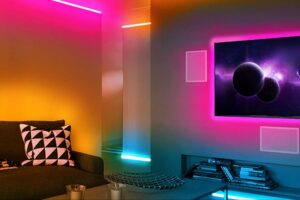LED Lights: Discover the Top 7 Benefits of Using LED Lights
Are you tired of constantly replacing traditional light bulbs in your home or business? Perhaps you’re looking for a more energy-efficient lighting solution that can save you money on your monthly utility bills. Look no further than LED lights! In this article, we’ll dive into the top 7 benefits of using LED lights and why they’re a smart choice for any property.
- Energy Efficiency
One of the most significant advantages of LED lighting is its low energy consumption. Unlike traditional incandescent bulbs that waste energy as heat, LED lights convert up to 90% of their energy into light. This means they require less power to produce the same amount of light, which ultimately saves you money on your electricity bill.
- Long Lifespan
LED lights also have an incredibly long lifespan, lasting up to 25 times longer than traditional bulbs. This means you won’t have to replace them as frequently, which is not only convenient but also better for the environment as it reduces the amount of waste generated by discarded light bulbs.
- Durability
LED lights are highly durable and can withstand harsh conditions without breaking or losing brightness. They’re resistant to shocks, vibrations, and extreme temperatures, making them an ideal choice for outdoor lighting or commercial applications.
- Environmentally Friendly
Because LED lights use less energy and last longer, they’re a more environmentally friendly lighting solution compared to traditional bulbs. They also don’t contain harmful chemicals like mercury, which can be found in fluorescent bulbs, making them easier to dispose of safely.

- Versatility
LED lights come in a wide range of shapes, sizes, and colors, making them a versatile lighting option for any space. Whether you’re looking for warm or cool lighting, directional or ambient, there’s an LED light for every need.
- Improved Safety
LED lights emit very little heat, reducing the risk of burns and fire hazards. They’re also free of UV radiation, making them safer for use in museums, art galleries, and other spaces where UV exposure can damage artwork or other sensitive materials.
- Cost-Effective
While LED lights may have a higher upfront cost compared to traditional bulbs, their long lifespan and energy efficiency ultimately make them a cost-effective lighting solution. Over time, you’ll save money on replacement bulbs and electricity bills, making LED lights a smart investment for any property.
LED lights (short for Light Emitting Diode) are a popular and energy-efficient alternative to traditional incandescent bulbs. There are several types of LED lights, each with its own unique properties and uses. These are a few examples of the most prevalent types:
LED bulbs:
These are the most common type of LED lights and are designed to replace traditional incandescent bulbs. LED bulbs come in a variety of shapes and sizes, including A-shaped bulbs (which are similar in shape to traditional bulbs), candelabra bulbs, and globe bulbs.
LED strips:
These are flexible, self-adhesive strips of LEDs that can be cut to fit almost any surface. LED strips are commonly used for decorative lighting, backlighting, and accent lighting.
LED spotlights:
These are directional lights that are designed to focus light in a specific area. LED spotlights are commonly used for accent lighting, task lighting, and outdoor lighting.
LED floodlights:
These are high-intensity lights that are designed to illuminate large outdoor areas, such as parking lots, stadiums, and building facades.
LED tubes:
These are long, tubular lights that are designed to replace traditional fluorescent tubes. LED tubes are commonly used in commercial and industrial settings, such as offices, warehouses, and factories.
LED grow lights:
These are specially designed LED lights that are used to grow plants indoors. LED grow lights emit specific wavelengths of light that plants need for photosynthesis.
Each type of LED light has its own unique features and benefits and can be used in a variety of settings and applications.
Conclusion:
LED lights offer a multitude of benefits that make them an excellent lighting solution for any property. From energy efficiency and long lifespan to durability and versatility, LED lights are a smart investment that can save you money while also being environmentally friendly. Consider switching to LED lights for your next lighting upgrade and enjoy the many benefits they have to offer.






More Stories
The Gear Behind the Gleam: Advanced Cleaning Equipment Redefining Clean Spaces
Home Improvement: Why Is Furniture Necessary in a House?
Home Improvement: Low-Cost Upgrades to Boost Your Living Space!